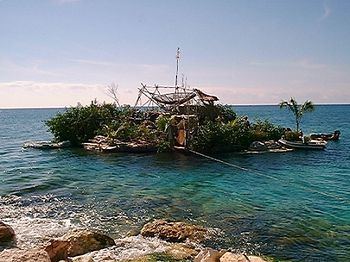 | ||
Similar Xel‑Ha Park, No Man's Land Fort, Playa Norte, Kamfers Dam, Thilafushi | ||
Spiral Island is the name of a floating artificial island built in Mexico by British artist Richart "Reishee" Sowa. It was destroyed by Hurricane Emily in 2005; a replacement, Joyxee Island, has been open for tours since 2008.
Contents
Map of Joyxee Island, Mexico
Spiral Island has been featured in a number of newspapers and TV documentaries around the world, including in Japan and South Korea, and has been featured in an episode of the Ripley's Believe It or Not! TV series, and on the MTV program Extreme Cribs in 2011.
Spiral IslandEdit
The first Spiral island was located in a lagoon near Puerto Aventuras, on the Caribbean coast of Mexico south of Cancún; Sowa began constructing it in 1998. He filled nets with empty discarded plastic bottles to support a structure of plywood and bamboo, on which he poured sand and planted numerous plants, including mangroves. The island sported a two-story house, a solar oven, a self-composting toilet, and three beaches. He used some 250,000 bottles for the 66-by-54-foot (20 m × 16 m) structure. The mangroves were planted to help keep the island cool, and some of them rose up to 15 feet (4.6 m) high.
Almost all of the sand Sowa used for Spiral Island I was taken from the end of the beach, where it came up against the man-made rock pier on the edge of the canal system where the Island was tied. Due to the prevailing winds, beach-sand was constantly being piled up because of the constant motion of the waves and wind. The beach sand was dredged out using large machinery so that boats could continue to come through the canal. Since Sowa gathered 8 to 10 large buckets per week, the builders of Puerto Aventuras Canal did not need to dredge it again, as he was doing it for them.
The island was destroyed by Hurricane Emily in 2005. The island was washed completely onto the beach in one piece, and a small proportion of the bags of bottles washed up on the beach away from where it landed. The roots of the 7-year old, 7-metre (23 ft) tall mangroves were intertwined through the island's base and the strong net that was wrapped totally under the whole island helped to keep it together.
Joyxee IslandEdit
In late 2007 and 2008, Sowa built a replacement for Spiral Island in the waters of Isla Mujeres, the "Island of Women", also near Cancun. It opened for tours in August, 2008.
The new island was initially 20 metres (66 ft) in diameter, which has since expanded to 25 metres (82 ft), and plants and mangroves are already growing on it. It contains about 100,000 bottles. The new island has three beaches, a house, two ponds, a solar-powered waterfall and river, a wave-powered washing machine and solar panels. Volunteers helped with the project. Sowa will continue to make improvements to the Island, so it will always be a work of art in progress.
In May 2011, Reishee embarked on a project to berth his island out in Isla Mujeres Bay, as it was now too big for its current site off a pier in Laguna Majax. The Mexican Government also recognized Joyxee Island as an "Eco Boat" and therefore needed to comply with all current boating regulations, which involved the purchase of fire extinguishers, life ring buoys and emergency kits. The project was launched on kickstarter.com with a goal of $18,000. By the time the project had expired, it had nearly $5,000 pledged. Since Kickstarter only delivers the money when a project has succeeded in reaching its funding goals, no money was gained. Reishee later successfully relaunched the project with a more conservative $9,000 goal.
